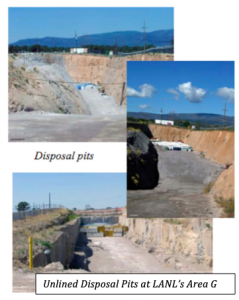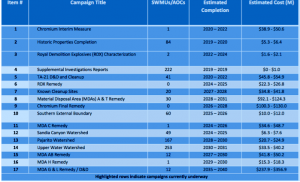
The Road to Genuine Los Alamos Lab Cleanup
Summary
Funding for nuclear weapons is still the priority at the Lab
- $1.7 trillion 30-year “modernization” program total current estimate across the nation
- LANL receives $2 billion annually for nuclear weapons work
Legacy Cleanup Program at LANL is getting started with new contractor
- Current cleanup estimate is $4.1 billion remaining to finish by 2036
- LANL cleanup has been receiving $195 to $220 million per year
Consent Orders are the key to cleanup
- A gutted a 2005 “Consent Order” would have forced the Department of Energy (DOE) and LANL to get more money for cleanup
- A giant loophole in the 2016 Consent Order allows DOE and LANL to say that they don’t have sufficient funding and can choose to exempt themselves from any cleanup
Material Disposal Area G (Area G) is the largest and most expensive cleanup site
- LANL’s own estimate to remove all the wastes from Area G came in at $29 billion
- Using actual cleanup estimates of another dumps, we can estimate the comprehensive cleanup of Area G could be as low as $7 billion
- Over 150,000 cubic meters are planned to be “capped and covered’ and left behind
Chromium Groundwater Plume
- Ending in 1972 the Lab flushed its cooling towers into Sandia Canyon with chromium
- Cr is now in the regional aquifer, on the border with San Ildefonso Pueblo
- Studies are being conducted to determine whether extraction can achieve active long-term chromium removal from the regional aquifer and if in-situ remediation to convert the chromium into a less dangerous form is an option
- Likely will have to pump and treat for a long time
RDX “Royal Demolition Explosive” Explosives Plume
- Explosives machining wastewater discharged resulted in RDX in soil and water
- RDX is in the regional aquifer.
- Likely will have to pump and treat for a long time
Technical Area 21
- From 1952 to 1986, a liquid-waste treatment plant discharged radionuclides from a plutonium-processing facility into DP Canyon and into buried tanks
- MDAs A & T at TA 21are expected to not be completely transferred to LA County because of the large amount of wastes planned to be left behind despite the fact that LA County plans to use the rest of area as a commercial industrial park.
Material Disposal Area C at TA-50
- Solid waste containing hazardous constituents and radioactive waste was disposed between 1948 and 1974
- The depths of the 7 pits and shafts at MDA C range only up to 25 ft.
- A total of 28 contaminants have been detected in the vapor plume beneath
- The assumed ”cap and cover” would leave the wastes permanently buried in place
2016 Consent Order Campaigns
Below is the Environmental Management Los Alamos (EM-LA) Lifecycle Cost Estimate (LCE) table for cleanup based on the “campaign approach” giving the estimated cost and completion dates.[1] The table is aligned with the 2016 Consent Order and has 17 Soil and water campaigns identified. As one campaign completes, the next scheduled campaign is supposed to start, but none are complete and multiple campaigns are underway simultaneously. The items in blue are currently underway.

Recommendations:
- Reject LANL’s plans to “cap and cover” Area G, its largest dump, along with several others, turning the Lab into a permanent nuclear waste dump. Say no to “cap and cover” that will forever threaten our precious water resources!
- Increase cleanup funding for Los Alamos to at least $250 million per year, and make sure it all really goes to cleanup.
- Overturn the 2016 Consent Order, which is a bad deal for NM, and reinstate the 2005 CO with milestone schedules modified as needed.
- Tell the New Mexican congressional delegation and the New Mexico Environment Department that you want full, comprehensive, job-producing cleanup.
- Support NukeWatch!
Read the pdf of this summary here
See the expanded version of this at:
https://nukewatch.org/lanl-genuine-cleanup-backgrounder-6-26-19/
[1] See https://www.energy.gov/sites/prod/files/2019/04/
f61/NNMCAB_EM-LA%20Program%20Overview%20and%20Update_November%202018.pdf
